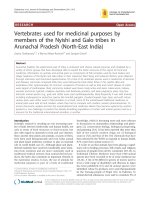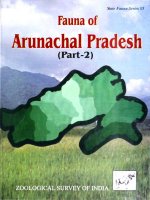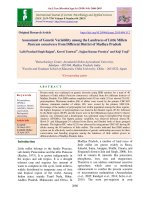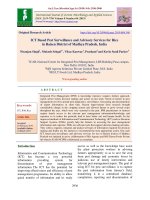Characterization of soils of lower dibang valley District of Arunachal Pradesh, North East India
Bạn đang xem bản rút gọn của tài liệu. Xem và tải ngay bản đầy đủ của tài liệu tại đây (186.33 KB, 7 trang )
Int.J.Curr.Microbiol.App.Sci (2018) 7(7): 2858-2864
International Journal of Current Microbiology and Applied Sciences
ISSN: 2319-7706 Volume 7 Number 07 (2018)
Journal homepage:
Original Research Article
/>
Characterization of Soils of Lower Dibang Valley District of
Arunachal Pradesh, North East India
Sangey Chom Thungon1, T.J. Ramesha2 and Channakeshava3*
1
2
Krishi Vigyan Kendra, Lower Dibang Valley District, Arunachal Pradesh, India
Soil Science and Agriculture Chemistry, Agriculture College, Hassan, Karnataka, India
*Corresponding author
ABSTRACT
Keywords
Organic Carbon
values, nitrogen
status, P, Iron,
Manganese content
Article Info
Accepted:
20 June 2018
Available Online:
10 July 2018
A field study on Characterization of soils of Lower Dibang Valley District of Arunachal
Pradesh, North East India was carried out at Krishi Vigyan Kendra, Lower Dibang Valley
district of Arunachal Pradesh North East India during 2017-18. The soil properties of different
villages revealed that the soil reaction (pH) ranges from 4.3 to 5.3. The lowest soil pH was
recorded in Rayang village and the higher pH value of 5.3 recorded in Kangkog, Balek and
Rukmo villages. Organic Carbon values ranged from 0.80-2.00 and are categorized as medium
to high in range. The soluble salt content of soil measured in terms of electrical conductivity of
soil solution (dS/m) which recorded as normal in range in all the soils of the villages (0.02 to
0.3 dS/m). The soils of different villages, 23.0 percent of soil samples belongs to low category
with respect to available nitrogen status and 40 percent of soil samples fall in the category
medium and high. The available nitrogen content ranges from 118.7 to 366.5 kg/ha). The
available P content of soil ranges from 20.7 to 94.73 kg/ha. However higher P content was
recorded in Jia village and lowest P content recorded in Rumo village. Higher P content in soil
was due to higher organic carbon content of soil where P fixation in soil reduced and which
resulted in more availability of P in soil. In general 61.3 percent soils are high in K status and
38.46 percent soils belongs to medium in range of K in soils. However, none of the soils fall
under category of low K status in soil. The maximum Sulphur content was recorded in
Horupahar village which recorded highest of 65 kg/ha (high in rage).Sulphur content ranges
from 14.0 to 65.0 kg/ha. As regard to micronutrient status of soil, the available zinc content of
soil ranges from 0.18 to 2.74 ppm. In general 23.0 percent of soils belongs to high Zinc content
of soil and 10.0percent of soils categorized as low in Zinc status and 20 percent of soils belongs
to medium in Zinc status. The available boron content of soil ranges from 0.18 to 6.53 ppm
among the soils of different villages. However the 69 percent of soils fall in the category of
higher boron content, 23 percent soils belongs to medium in boron content and 15 percent soils
having low boron content in soils. The Manganese content in soil ranges from 0.45 to 19.5 ppm
across the villages of lower Debang Valley. However higher manganese content of soil
recorded in Kebali, Balek, Jia, Iduli, Horupahar, Bolung, Koronu and Meka and cover 53.84
percent of soils of different villages. Iron content of soil ranges from 21.0 to 106 ppm and all
the soils belongs to higher range of iron status in soil. The available copper content of soil
ranges from 0.37 to 4.09 ppm among the soils at different locations.
2858
Int.J.Curr.Microbiol.App.Sci (2018) 7(7): 2858-2864
Introduction
Materials and Methods
Soil is a natural body with the existence of
human beings is closely related. It is the
mantle on the land surface that acts as the
medium for plant growth. Organic farming is
primarily in operation in areas under shifting
cultivation and traditional land use systems in
north east India. Nearly 57.1% of total
geographical area in India is under the threat
of land degradation mainly by water erosion.
On an average 37.1% of total geographical
area in North East India is in degraded state.
The fertiliser use in most of the state of region
is far below national average.
Study site
North East India is becoming increasingly
deforested and its crop productivity is
declining primarily due to shortening of jhum
cycles. Natural as well as anthropogenic
activities have rendered natural resources viz.,
soil, water and forests vulnerable to such
extent that river flow during monsoon season
causes slides and erosion and during dry
season, the problems of water shortage is
ensured. However non forest activities are
expanding rapidly worldwide at the expense of
natural forests and at a pace which is much
faster in environmental fragile hilly tract
Globally,
agricultural
expansion
and
infrastructural development contributes 37%
of forest degradation, responsible for 1/3rd of
tropical deforestation. Arunachal Pradesh is
the land of raising sun comprises of
mountainous and sub-mountainous portions of
Himalayan systems in its extremity, covering
an area of 83743 sq.kms.
In this contest it is an obligatory to
characterize soils of Lower Dibang Valley
District region for identification of production
constraints related to soil chemical properties
including nutrient status of soils for finding
suitable solutions and also to overcome
problems of ecological imbalance to achieve
sustainability of the existing ecosystem in the
region.
Lower Dibang Valley District, is the 15th
district of Arunachal Pradesh is located in the
Eastern part of Arunachal Pradesh.. The
Lower Dibang Valley named after River
Dibang, one of the tributaries of mighty River
Brahmaputra, which flows in the district. The
district has three sub-division viz. Roing,
Dambuk and Hunli and 6 (six) administrative
circles namely, Hunli, Desali, Dambuk,
Paglam, Koronu and Roing
The district is bounded on the North by
Dibang Valley District and China, on the East
Lohit District, and on the west East Siang and
Upper Siang District of Arunachal Pradesh
and on the south Sadiya Sub-division of
Tinsukia district, Assam state. It covers an
area of 3900 Sq.Kms with a population of
53985 (As per 2015 census), altitude is 390
mtrs and relative humidity (62.92-90.36
(Source: KVK Annual Report-2016-17). It lies
between 270- 30’ N to 280 – 33’N lattitude, 950
–15’E to 960 – 30’E longitude.
The district possess good climatic condition
with agroclimatic zones like Sub – tropical
Plain Zone characterized by hot summer and
moderately cool winter with mean annual
rainfall varies from 2590 – 3390mmand Mid
tropical Hill Zone characterised by mild
summer and moderate to severe winter. The
mean annual rainfall ranges between 2000 to
5000 mm. Also soil types of undulating
upland of 4715 ha area characterised with
soils are strongly to moderately acidic in
nature (pH 4.5 to 7.2), Soils of gentle slopes of
11779 ha area characterised by Deep, well to
imperfectly drained, fine/ fine loamy/ coarse
loamy or coarse silty with moderate erosion
and slight to moderate flood hazard. Soils of
level to nearly level flood plain of 7073 ha
area characterised by Deep, well to
2859
Int.J.Curr.Microbiol.App.Sci (2018) 7(7): 2858-2864
moderately well drained, coarse loamy to
coarse silty with moderate flood hazard. Soils
on channel bars are moderately shallow,
excessively drained and sandy in texture.
Soil sampling and laboratory analysis
During the year 2015-16,soil samples were
collected (using a steel corer, 5 cm inner
diameter) from four adopted villages namely
Kangkong, Jia, Rukmo, Kebali and Balek
under the Mera Gaon Mera Gaurav, while,
during the year 2017-18, soil sample collected
from Rukmo, simari, Horupahar, Rayang,
Denlo, Koronu, Bhismaknagar, Meka, Bolung
and Iduli villages.
Samples were brought to the laboratory to
analyze their physico-chemical characteristics.
Soil samples were air-dried, grinded and
sieved (<150mm) prior to the samples used for
physico-chemical analysis. The collected
samples
were
analysed
using
MRIDAPARIKSHAK-A minilab for soil
analysis and fertiliser advisory developed by
ICAR-Indian institute of Soil Science, Bhopal
for major nutrients like available Nitrogen,
Phosphorous and Potassium and minor
nutrients like copper, manganese, iron, zinc,
boron, sulphur, pH, and EC and organic
carbon. After the analysis of soils, the soil
Health cards distributed to farmers during
world soil day programme to create awareness
among farming community about soil health
and its importance.
Soil reaction (pH)
Results revealed that soil reaction of soils of
different villages of lower Dibang valley
district ranges from 4.3 to 5.3. The lowest soil
pH was recorded in Rayang village and the
higher pH value of 5.3 recorded in
Kangkog,Balek and Rukmo villages. The Low
soil pH was associated to the leaching of basic
cations (Ca, Mg and K) due to heavy rain
during the monsoon season which resulted in
retention of hydrogen, iron and aluminium
ions with strong binding force with charged
soil particles thereby increases soil acidity.
Soil acidification often leads severe problems
to the maintenance of slash-and-burn
agricultural fields in humid tropics area.
Organic carbon (%)
Organic Carbon values ranged from 0.802.00. Different agricultural practices decrease
the soil organic matter with stored carbon in
soils as well as global carbon balance (Sellers
et al., 1997, Lal 2001; Santra 2012). Soil
carbon and nitrogen losses are associated with
decreased plant organic matter inputs and high
decomposition rate and erosion which are
mainly associated with agricultural lands. Soil
organic carbon ranged between 0.59% and
2.38% in the present study, which is higher
than the values (0.8-1.24%) reported by
Manuwa (2009) and 1.42-1.74% by
Arunachalam (2002) from the Jhum lands in
north east India
Results and Discussion
Soluble salt content of soil (dS/m)
The results with respect to soil properties like
pH, Ec, Organic carbon, available nitrogen,
phosphorus, Potassium Sulphur, zinc, boron,
iron, Manganese and copper at different
villages have been presented in table 1 and
each parameters discussed in paragraph as
below.
The soluble salt content of soil measured in
terms of electrical conductivity of soil solution
(dS/m) which recorded as normal in range in
all the soils of the villages (0.02 to 0.3 dS/m).
The lower soluble salt content of soil was
recorded in Koronu soils and higher salt
content recorded in Kebali soils. Lower salt
content was attributed to leaching of salts due
2860
Int.J.Curr.Microbiol.App.Sci (2018) 7(7): 2858-2864
to higher rainfall and higher permeability of
soils for flow of salts to lower soil depth as the
retention of salts decreased due to low clay
and organic matter content of surface soils.
Available Nitrogen content in soil (kg/ha)
Among the soils of different villages 23.0
percent of soil samples belongs to low
category with respect to available nitrogen
status and 40 percent of soil samples fall in the
category medium and high in nitrogen status
of soil. The available nitrogen content ranges
from 118.7 to 366.5 kg/ha). The higher
available nitrogen content of soil was recorded
in the villages of Koronu 366.5 kg/ha), Meka
315.7 kg/ha) and Reyang (366.5 kg/ha) was
attributed to continuous application of
nitrogen fertilizer under intensive cultivation
practices in the location. These results were in
agreement with findings of Bhuyan (2001).
Available P content of Soil (kg/ha)
The available P content of soil ranges from
20.7 to 94.73 kg/ha. However higher P content
was recorded in Jia villageand lowest P
content recorded in Rumo village. Higher P
content in soil was due to higher organic
carbon content of soil where P fixation in soil
reduced and which resulted in more
availability of P in soil. Application of lime to
acid soils during cultivation of crops can also
increases availability of P in soil than at low
pH soil without lime application (Ghosh
etal,1980). Addition of lime decreases activity
of Fe and Al in soil thus reduces P fixation in
soil.
Available K content in soil (kg/ha)
The available K content of soil generally
increased due to application of K to soil
during cultivation practices and also
accumulation of 1:1 and 2:1 type of clay
minerals which contribute for accumulation of
K in soil. In general61.3 percent soils are high
in K status and 38.46 percent soils belongs to
medium in range of K in soils. However, none
of the soils fall under category of low K status
in soil (Bhuyan, 2001). The higher K content
of 431.2 kg/ha recorded Meka location and
lowest K was recorded in Jia village (133.0
kg/ha).
Available S content of soil (kg/ha)
The sulphur content of soil was higher in soils
of Horupahar, Kebali, Kengkong Balek,
Simari,and Meka villages which categorized
as medium in range followed by Jia, Koronu
and Rayang villages which contain low in
range. The maximum Sulphur content was
recorded in Horupahar village which recorded
highest of 65 kg/ha (high in rage). The higher
S content was attributed to adsorption of
sulphur on soil exchange surface of 1:1and 2:1
type of clay minerals through clay humus
complexes which retain more sulphur in soil.
However, desorption and leaching of sulphur
takes place where organic carbon and clay
content in soil decreased (Hudson, 1963).
Addition of S as fertilizer in the production
practices of field crops in the villages also
contributed for higher S status of soil.
Micronutrient status of soil (Table 2)
Available Zinc (ppm)
Among the villages, the available zinc content
of soil ranges from 0.18 to 2.74 ppm. In
general 23.0 percent of soils belongs to high
Zinc content of soil and 10.0percent of soils
categorized as low in Zinc status and 20
percent of soils belongs to medium in Zinc
status. The higher zinc status of soil was
attributed to higher accumulation of organic
matter in soil and also retention of zinc in
chelated form with organic constituents in
soil.
2861
Int.J.Curr.Microbiol.App.Sci (2018) 7(7): 2858-2864
Month
April
May
June
July
August
September
October
November
December
January
February
March
Rainfall (mm)
1279.38
2331.07
3199.85
4720.81
6354.96
6939.20
2235.68
1033.67
1038.56
66.96
237.45
Village
pH
Kebali
Kangkong
Balek
Rukmo
Jia
Iduli
Horupahar
Bhismaknagar
Bolung
Koronu
Simari
Meka
Rayang
5.2
5.3
5.3
5.3
4.7
5.0
4.9
4.7
5.2
5.2
4.5
4.4
4.3
EC
(dS/m)
0.26
0.09
0.16
0.3
0.07
0.23
0.07
0.13
0.04
0.02
0.11
0.22
0.16
Table.1 Weather data
Temperature 0 C
Maximum
24
28.33
30.53
29.22
33.25
28.03
29.67
26.33
23.03
21.58
23.96
23.06
Relative Humidity (%)
Minimum
19.86
24.16
25.36
24.74
27.38
24.36
21.51
17.80
15.41
14.03
15.85
16.58
Table.2 Soil samples analysed for various parameters
OC
N
P2O5
K2O
S
Zn
(%)
Kg/ha
Kg/ha Kg/ha
Kg/ha ppm
1.67 265.53 25.8
198.6
24.96
2.74
0.91 170.97 21.58
178.51 24.88
1.92
0.99 215.33 24.63
261.4
22.56
2.31
0.80 165.6
20.7
176.14 24.14
1.80
1.27 299.8
94.73
133.1
14
1.0
1.92 291.9
70.60
374.0
31.0
0.18
2.00 118.7
25.91
379.2
65
10.7
1.00 261.6
25.02
249.2
29
0.18
1.07 271.2
32.17
306.5
34
1.6
1.74 366.5
40
338
15.00
0.17
1.74 166.3
43.79
185
29
1.62
1.59 315.7
39.92
431.2
22.00
2.22
1.16 366.5
28.70
253.5
16.9
0.89
2862
90.36
85.58
86.73
86.70
85.58
81.76
76.41
63.83
64.90
64.25
62.92
69.54
B
ppm
5.59
2.00
2.11
2.99
2.02
1.28
0.18
1.28
6.53
2.2
0.9
5.18
2.20
Fe
ppm
56.33
38.10
106.1
61.12
27
36.7
13.0
36.7
21.0
31.3
33
25.1
22.8
Mn
ppm
2.12
1.72
2.82
1.85
2.25
19.3
4.45
1.93
4.7
4.0
0.45
2.69
1.35
Cu
ppm
0.6
0.83
1.67
0.72
0.37
2.43
4.09
2.43
0.46
1.1
1.52
1.93
0.90
Int.J.Curr.Microbiol.App.Sci (2018) 7(7): 2858-2864
Available Boron in soil (ppm)
The available boron content of soil ranges
from 0.18 to 6.53 ppm among the soils of
different villages. However the 69 percent of
soils fall in the category of higher boron
content, 23 percent soils belongs to medium
in boron content and 15 percent soils having
low boron content in soils. The higher and
medium boron content of soils may be due to
application of boron fertilizer to crops grown
in the area in the intensive cropping system.
Lower boron content in soils was due to
fixation of Boron with Fe and Al which are
predominant in soil and resulted in low
availability of boron in soil (Nayak et al.,
2000).
Available Manganese content in soil. (ppm)
The Manganese content in soil ranges from
0.45 to 19.5 ppm across the villages of lower
Debang Valley. However higher manganese
content of soil recorded in Kebali, Balek,Jia,
Iduli, Horupahar, Bolung, Koronu and Meka
and cover 53.84 percent of soils of different
villages. Among the soils of different villages
38.46 percent soils having medium in range
with respect to Manganese content of soil.
Higher Manganese content of soils due to
presence of dominant ferro magnesiun
minerals (Magnetite) and parent material
which contains higher manganese content
from which soil formed (Gupta et al., 2000).
Available iron content in soil (ppm)
It is interesting to note that all the soils at
different villages contains higher iron content
in soil and classified as higher in range. The
higher Iron content may be due to
predominance of iron bearing minerals such
as Haematite and Magnetite and clay minerals
like chlorite and vermiculite. Availability of
iron in ferrous form is more in soil upon
submergence during cultivation of crops like
rice sometimes resulted in toxicity to the
crops which can be managed through
application of lime. Under climatic conditions
of warm and humid condition due to intensive
and deep weathering leaching of silica leaving
behind iron and alumina contributed for
higher iron content in soil (Gupta et al.,
2000).
Available copper content in soil (ppm)
The available copper content of soil ranges
from 0.37 to 4.09 ppm among the soils at
different locations. The higher copper content
recorded in soils of Balek, Iduli, Horapuhar,
Bhismaknagar and Meka villages. In rest of
the villages the copper content recorded as
low and medium in range. The higher copper
content in soils was attributed to application
of Copper based fungicides and also due to
presence of copper bearing minerals such as
chalcopyrites which contribute higher Copper
content of soils (Nayak et al., 2000).
Acknowledgement
The main author is thankful to the Senior
Scientist and Head for providing facilities to
carry out the soil sampling and analysis work
and bring out this research paper.
References
Arunachalam, A., (2002), Dynamics of soil
nutrients and microbial biomass
during first year cropping in an 8-year
jhum cycle. Nutrient Cycling in
Agroecosystems, 64, pp 283–291.
Bhuyan SI.2001. Soil nutrients status in
prominent agro-ecosystems of East
Siang district, Arunachal Pradesh.
International Journal of Environmental
Sciences. 2013; 3(6).
Das, D.K. 2003. Micronutrients: Their
Behavior in Soils and Plants, Kalyani
Publishers, New Delhi, pp.148-149.
2863
Int.J.Curr.Microbiol.App.Sci (2018) 7(7): 2858-2864
Hodgson, J.F. (1963). Chemistry of
micronutrient elements in soils.
Advances In Agronomy. 15: 69-94.
Ghosh, A.B. and R. Hasan.1980. Soil Fertility
Map of India, Indian Agricultural
Research Institute, New Delhi.
Gupta,G.P., Khamparia, R.S., Sharma, B.L.
and Y.M. Sharma (2000). Extractable
micronutrients in relation to properties
of some red and yellow soils of
Madhya Pradesh. Ann.agric.Res.21(4):
522-526
Lal, R., (2001), Potential of desertification
control to sequester carbon and
mitigate the greenhouse effect,
Climate change, 51, pp 35–72.23
Lal, R., (2001), Potential of desertification
control to sequester carbon and
mitigate the greenhouse effect,
Climate change, 51, pp 35–72.23
Manuwa, S.I., (2009), Physico-chemical and
dynamic properties of termite mound
soil Relevant in sustainable food
production, African crop science
conference proceedings, 9, pp 365–
369.
Mete,
P.K. and A. Samanta (1996).
Distribution of iron fractions in red
and lateritic soils of West Bengal. J.
Maharashtra Agric. Univ.,21(3):327329.
Nayak, D.C., Mukhopadhyay and D. Sarkar
(2000). Distribution of some available
nutrients in alluvial soil of Arunachal
Pradesh
in
relation
to
soil
characteristics. Indian J. Soc. Soil Sci.,
48(3): 612-614
Santra, P., Kumawat, R.N., Mertia, R.S.,
Mahla, H.R. and Sinha, N.K., (2012),
Spatial variation of soil organic carbon
stock in a typical agricultural farm of
hot arid ecosystem of India, Current
science, 102, pp 1303-1309
Sellers, P. J., Dickinson, R.E., Randall, D.A.,
Betts, A.K., Hall, F.G., Berry, J.A.,
Collatz, G.J., Denning, A.S., Mooney,
H.A., Nobre, C.A., Sato, N., Field,
C.B., Sellers, A.H., (1997), Modeling
the exchanges of energy, water, and
carbon between continents and the
atmosphere, Science, 275(5299), pp
502–509.
How to cite this article:
Sangey Chom Thungon, T.J. Ramesha and Channakeshava. 2018. Characterization of Soils of
Lower Dibang Valley District of Arunachal Pradesh, North East India.
Int.J.Curr.Microbiol.App.Sci. 7(07): 2858-2864. doi: />
2864









